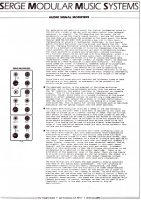In the image above, the blue trace on the Mordax DATA is the original sine wave (which has just a single fundamental harmonic) from an Expert Sleepers Disting, and the green trace is the nicely-rounded “folded” output from the Serge Wave Multipliers. The resulting harmonic spectrum is shown in the lower right. The big gap between the two leftmost spikes are the first and third harmonics, with the even-numbered second harmonic missing; you can see tiny spikes for the fourth and sixth harmonics between the taller odd harmonics.

Something important to know is that the original Serge modular’s audio levels were closer to line level (1v to 2.5v peak to peak, in the Serge’s case) than Eurorack levels (10-20v peak to peak), and most if not all Serge recreations follow this. As a result, you will need to do some processing of your oscillator’s waveforms both before and after a sound modifying module based on Serge circuits. In this case, I am using an attenuator between the VCO and the Wave Multiplier, which helps tune in the initial sound before you’ve applied voltage control to its depth. On the output side, I split the audio signal into two with a stackable cable and plugged it into two inputs of a mixer (the top channel pair of the Happy Nerding 3x MIA in the image at the top of this page), doubling its strength before passing it onto the Moog Mother-32’s filter. I’d suggest adding even more gain on the output if you can by splitting the signal with a passive mult and running into more mixer inputs, and/or choosing a mixer that has more gain per channel than just “unity” (x1).
Despite the signal level issue, this is one of my favorite sound-modifying modules; I feel it has a more easily-tamed, organic sound than many wave folders, which makes it friendly to work with while still adding a lot of harmonics and motion to simple waveforms such as sine waves and triangles. (Of course, you can feed more complex waveforms such as a sawtooth through it as well.)


